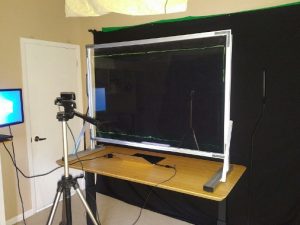Synchronous Labs/Demonstrations
Introduction
When considering online synchronous labs and substitutes, focus on the foundational learning outcomes that can be achieved teaching online/remotely.
In a synchronous lab you can use videoconferencing tools to convert the instructional experience into an interactive lecture or participatory activity.
- Use video to demonstrate how to move through lab protocols and activities.
- Invite students to apply their analytical skills to data individually or in small groups.
- Incorporate polls or other response tools to contrast results across individuals or groups.
Teach key concepts/diagrams and complex processes by substituting whiteboards/chalkboards with digital alternatives.
- Use an overhead camera and a webinar tool (Zoom)
- Use Lightboard with a webinar tool (Zoom)
Resources
Using LightBoard for Synchronous Teaching/Labs

A lightboard is framed glass illuminated with LED lights. The instructor stands behind the glass and can write notes, teach concepts, draw diagrams, solve equations and/or problem solve using florescent whiteboard markers. As the camera feed is flipped and the instructor is behind the glass, the instructor doesn’t obscure any of the writing on the board. The instructor can speak and explain ideas quickly with visual aids, and gesture or point out parts of the board using their hands.
When using a lightboard with a web conferencing platform such as Zoom, the instructor can also use PowerPoint in conjunction with the lightboard to interact with the slides and produce a highly engaging lesson. It also allows the instructor to face their audience, where they can maintain instructor presence by engaging the students with eye contact and gestures.
A lightboard allows faculty and instructors, with little technical knowledge, to create online synchronous sessions that are closer to the real classroom experience. It also allows for more interactive options, for example, a class brainstorm where the instructor can list the student’s ideas/suggestions on the lightboard.
LightBoard Depot: https://www.lightboarddepot.com/
LightBoard as a Teaching Tool | LightBoard Depot
A short introduction to the LightBoard and how it can be used to take your online lectures, meetings, webinars and conferences to the next level!
Introduction to Lightboard
Michael Justason, Program Chair, Civil Engineering Infrastructure Technology and Assistant Professor in the Faculty of Engineering at McMaster University, was looking for ways to effectively teach engineering online. Drawing diagrams, rendering equations and problem solving online was a challenge. Professor Justason experimented with tablets, recording on the SMART Board and voice-overs on PowerPoint to aid him in his teaching, but wasn’t getting the desired results.
Lightboard Demo
Examples of course-content recorded using the Lightboard are presented in this video. A demonstration of synchronous virtual-classroom teaching is also given. Basic use of the Lightboard is discussed including suggested best-practice, advantages and disadvantages. The integration of existing course content (for example PowerPoint slides) will also be demonstrated. Instructors who use a whiteboard and/or chalkboard in the classroom may be particularly interested in this session.
Facilitators: Prof. Michael Justason, Assistant Professor, Walter G. Booth School of Engineering Practice and Technology
References
Using Lightboards to Successfully Teach Science, Technology, Engineering, and Math (STEM) Subjects Online at McMaster University, Hamilton, Ontario, Canada
https://teachonline.ca/pockets-innovation/using-lightboards-successfully-teach-science-technology-engineering-and-math-stem-subjects-online
Virtual Labs for Remote/Online Courses
https://onlinelearning.utoronto.ca/virtual-labs/

